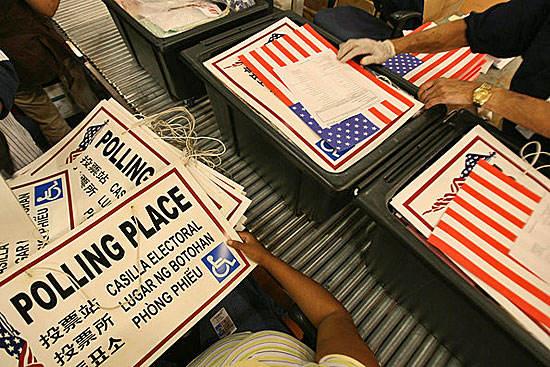L.A.’s ballot box language boom
February 8, 2012

From Bengali to Thai, L.A. County voting officials are brushing up on some new languages for voters.
The nation’s most linguistically diverse ballot is about to offer even more ways to say “I voted.”
This June, when the polls open for the 2012 primary elections,Los Angeles County voters will be able to cast ballots in three new languages and receive oral translations in two more.
The addition of written voting material in Hindi, Khmer and Thai, and the planned recruitment of poll workers who can give bilingual assistance in Gujarati and Bengali, will bring to eleven the number of languages—other than English—in which L.A.County citizens will be able to vote.
Ballots and voting literature have been available for at least a decade in Chinese, Japanese, Korean, Vietnamese, Tagalog, Spanish and English. Registrar-Recorder/County Clerk Dean Logan says the additional voting material and recruitment could cost up to $1 million, but is necessary to comply with the federal Voting Rights Act.
That law generally requires language assistance for voters when a non-English-speaking minority exceeds 10,000 voting age citizens or 5 percent of a jurisdiction’s electorate.
“It’s a federal mandate that unfortunately does not come with federal funding, so we have to absorb it into our own budget,” says Logan. “It’s a challenge, but it’s also a great opportunity to ensure that we’re getting information to people in ways that they can access and comprehend.”
Efrain Escobedo, executive liaison forLogan’s office, attributes the need to a number of factors, including an increase in the number of naturalized citizens from India and Southeast Asia, and the migration of Asian-American voters from other states. Escobedo added that this year’s mandate required extra analysis because it was issued not by nationality, but by ethnicity and race.
“They gave us two categories—Asian Indian and ‘Other Asian Non-Specified,’ ” says Escobedo. “But India has over 122 recognized languages and 22 official languages. So when you tell us ‘Asian Indian,’ that doesn’t really help.”
Meanwhile, a search for non-Indian “other” Asian groups that weren’t already getting bilingual assistance yielded more than 80,000 residents of L.A. County with a half-dozen different national origins.
Eventually, Escobedo says, county analysts narrowed the list with the help of targeted census data, community groups such as the Asian Pacific American Legal Center and the Artesia-based South Asian Network and analysis from the Center for the Study of Immigrant Integration at the University of Southern California.
In addition to leading to the new languages on the ballot and in polling places, the county’s research yielded a rough sketch of the county’s dynamic immigrant populations. For instance:
- Los Angeles County now has more than 1.35 million people who identify themselves as Asian.
- The county’s largest Asian community is non-Taiwanese Chinese, which represents nearly 372,000 people or about 27.5 percent of the Asian community.
- Filipinos run a close second with nearly 329,000 residents, or about 24.3 percent of the county’s Asians. Another 216,000 or so residents are Korean, making up about 16 percent of the Asian community.
- More than 76,000 county residents identified themselves as Asian Indian in the 2010 Census, representing roughly 6 percent of the county’s overall Asian population. More than a third were naturalized citizens.
- About 20,000 of the county’s Asian-Indians are registered voters and more than two out of three have a college degree. The vast majority reported fluency in English, but about one in ten said that they don’t speak it well.
- The county’s immigrant population now includes more than 32,000 Cambodians, 23,000 Thais, 10,000 Indonesians, 9,000 Pakistanis, 6,100 Sri Lankans and 3,000 Laotians.
- Four out of every ten Cambodians are naturalized citizens, and more than a third of the county’s Cambodian population is registered to vote. But nearly 40% of Cambodians over age 25 in the county lack a high school diploma, and a third of the county’s Cambodian population speaks English poorly or not at all.
- The county’s Thai community also reports a 42 percent rate of naturalization. But only about 25 percent reported poor skills in English and more than four in ten have college degrees.
- Los Angeles County’s Thai communities are clustered in Cerritos, Glendale, L.A.and Long Beach. Cambodian clusters can be found in Long Beach, Signal Hill, Lakewood and Pomona. Meanwhile, Asian Indians are concentrated in Artesia, Cerritos, Diamond Bar, Walnut and L.A.
Posted 1/31/12












 405 bridge work causes a stink
405 bridge work causes a stink
